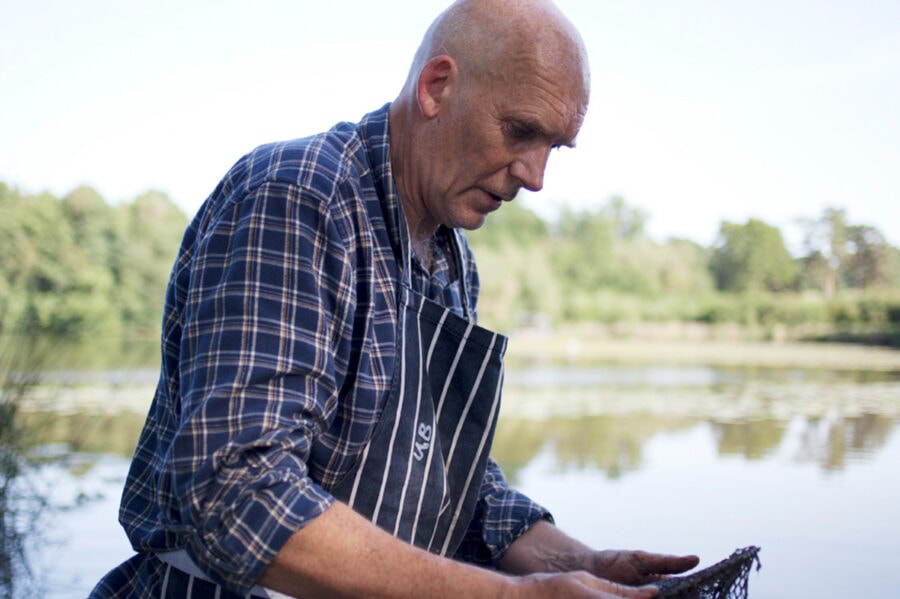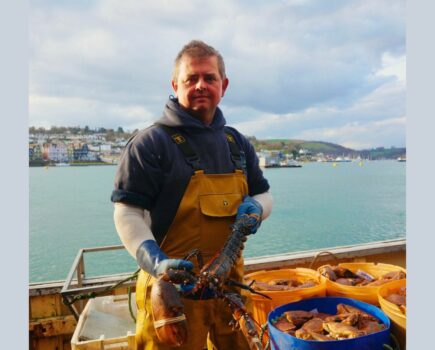“I often get told by my American guests that my crawfish boil is the best they’ve ever been to,” crayfisherman Bob Ring told Fishing News. “That’s a massive compliment, and I’m quite proud of that.”
Clapham-based Bob’s interest in crayfish has spanned more than two decades. “I first encountered crayfish on a boat trip in Scandinavia in the early 2000s. The following year, I borrowed a friend’s electric boat to go up to the source of the Thames. On that trip, I saw what I’d seen the previous year in Sweden – there was a large, dead crayfish floating in the water at Abingdon.
“I recognised it as an American signal crayfish, which is an invasive species. I looked into the population, and saw trapping as a good opportunity to help the environment by doing something that was written up as having no financially viable solution – the removal of these crayfish.
“I thought, OK, let’s investigate that – it seems easy enough to catch and sell them. Of course, it wasn’t as straightforward as that.”
From changing regulations, to competition from illegal trappers and the impact of Brexit on live exports, Bob – who sources his crayfish from a number of fisheries across the southeast of England – has encountered his fair share of challenges in establishing a viable business.
“When you start, you know nothing, and you know nobody. I had all the crayfish trapping bit to learn, and how to clean, grade and sell them. That was 21 years ago, and I’ve seen a lot of changes over that time.
“I’ve become so involved with these crayfish over the years, but only because I’m so stubborn. It’s often not been as straightforward as I thought it would be, but I’ve hung in there. At one point I thought about stopping – it was costing me money every year – but things have improved.”

American guests often ask me why my crawfish boil is better than any they’ve had before,” said Bob. “Our crayfish come from a nice, clean gravel lake or chalk stream – they haven’t been living in the mud. It’s also a better-size crayfish. I do everything else the same as they do it in Louisiana – though I use better stock.” (Photo: Charlie Lyne)
A lot of Bob’s catch these days goes to the animal-feed market. “I supply a lot of zoos. It’s mainly for otters – they’re the perfect customer. They want crayfish every week, they don’t want a changed menu – and they get through quite a few.”
However, with the crayfish season now well underway, Bob has to balance his trapping and processing responsibilities with hosting an event that provides a slightly different way of helping to reduce the crayfish population – his hugely popular Louisiana Crawfish Boil.
The event – held every Thursday from June until October at Gosnells Bar in Bermondsey, London – is a key focus of Bob’s working week.
“Last Monday I spent most of the day working on label design for my crawfish boil spice mix – which I’ve used for years, and is very popular. I’ve been going through packaging and labelling design so that I can have some product ready for the events.
“I’ve also been doing some spice mixing. I’ve mixed up around 30kg of spice mix – part of which I’ll need for the events.

Bob hosts his popular crawfish boils throughout the summer. “From these weekly boils I can get rid of about 80kg in an evening.” (Photo: Charlie Lyne)
On the day of an event, Bob’s first task is to gather all his supplies. “I’ll start the day with a trip to the supermarket to get the corn on the cob, small potatoes and watermelon. Hopefully if I get there at about 8am they’ll have everything I need.
“Next, I’ll drive at least 30 miles out of London to collect the crayfish and bring them back to my London depot where I store and process them. I need to be ready to head off to the venue by around 3.30pm.
“I’ll also cook up some chicken, which we serve before the crayfish, and load the other bits I need, such as the smoked sausages I order in, along with various boxes and trays. Then I’ll drive to the venue in Bermondsey.”
After decorating the venue, dressing the tables and checking all the kitchen equipment is working, Bob begins cooking.
“Come 4.30pm to 5pm, we’re usually set up and I’ll start heating the water. At around 6pm, I’ll start cooking. I have two huge 120-litre pots on the go. Each one will take around 40kg of crayfish.
“At around 7pm, the guests start to arrive. As people are being checked in, I’m full-on with the cooking. By about 7.15pm, I’m scooping all of the crayfish out of the pots. It all gets pretty frantic for about five to 10 minutes.
“The crayfish are put into a big plastic bucket with the spice mix, and I’ll add the potatoes, the corn on the cob, smoked sausage and butter and shake it all up. It’s then transferred to large trays, which get taken out and put
into the middle of tables where everybody helps themselves.
“Once the food comes out, the band – Crayfish Bob’s Crawdaddies – will start playing their Cajun-style music. They’ve written quite a few new crayfish- themed songs, but will also play some well-known ones.
“Once all the food is out, it’s just a question of topping people up.”
After serving the watermelon slices to finish, Bob begins the process of cleaning up and tidying away. “The event is normally all over by around 9.30pm. We’ll load the van up and leave by 10.30pm at the latest, and that will be that – until the next week.”
For more information click here.
This story was taken from the latest issue of Fishing News. For more up-to-date and in-depth reports on the UK and Irish commercial fishing sector, subscribe to Fishing News here or buy the latest single issue for just £3.30 here.
Sign up to Fishing News’ FREE e-newsletter here.








